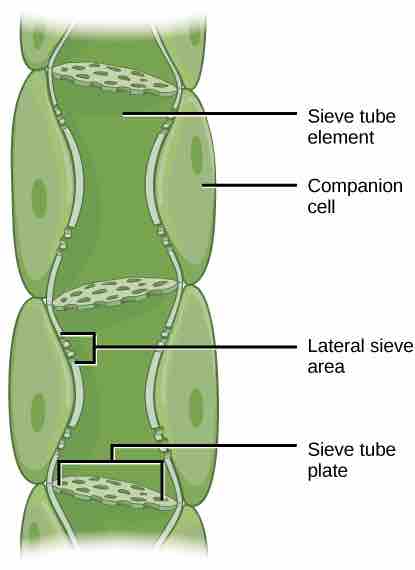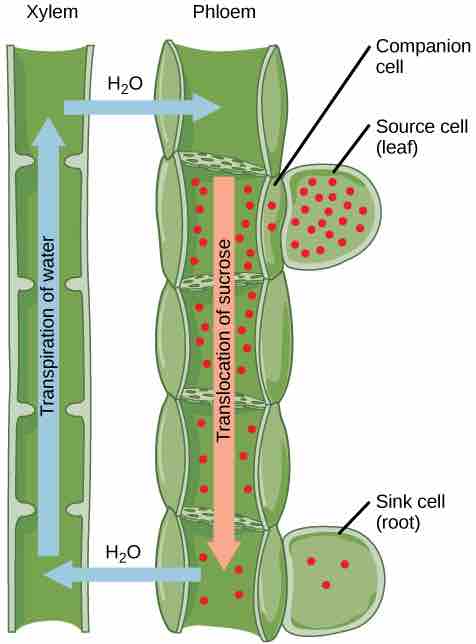Transportation of Photosynthates in the Phloem
Plants need an energy source to grow. In seeds and bulbs, food is stored in polymers (such as starch) that are converted by metabolic processes into sucrose for newly-developing plants. Once green shoots and leaves begin to grow, plants can produce their own food by photosynthesis. The products of photosynthesis are called photosynthates, which are usually in the form of simple sugars such as sucrose.
Sources and Sinks
Sources are the structures that produce photosynthates for the growing plant. The sugars produced in the sources, such as leaves, must be delivered to growing parts of the plant. These sugars are transported through the plant via the phloem in a process called translocation. The points of sugar delivery, such as roots, young shoots, and developing seeds, are called sinks. Seeds, tubers, and bulbs can be either a source or a sink, depending on the plant's stage of development and the season.
The products from the source are usually translocated to the nearest sink through the phloem. For example, photosynthates produced in the upper leaves will travel upward to the growing shoot tip, while photosynthates in the lower leaves will travel downward to the roots. Intermediate leaves will send products in both directions. The multidirectional flow of phloem contrasts the flow of xylem, which is always unidirectional (soil to leaf to atmosphere). However, the pattern of photosynthate flow changes as the plant grows and develops. Photosynthates are directed primarily to the roots during early development, to shoots and leaves during vegetative growth, and to seeds and fruits during reproductive development. They are also directed to tubers for storage.
Translocation: Transport from Source to Sink
Photosynthates are produced in the mesophyll cells of photosynthesizing leaves. From there, they are translocated through the phloem where they are used or stored. Mesophyll cells are connected by cytoplasmic channels called plasmodesmata. Photosynthates move through plasmodesmata to reach phloem sieve-tube elements (STEs) in the vascular bundles. From the mesophyll cells, the photosynthates are loaded into the phloem STEs. The sucrose is actively transported against its concentration gradient (a process requiring ATP) into the phloem cells using the electrochemical potential of the proton gradient. This is coupled to the uptake of sucrose with a carrier protein called the sucrose-H+ symporter.
Phloem STEs have reduced cytoplasmic contents and are connected by sieve plates with pores that allow for pressure-driven bulk flow, or translocation, of phloem sap. Companion cells are associated with STEs. They assist with metabolic activities and produce energy for the STEs .

Translocation to the phloem
Phloem is comprised of cells called sieve-tube elements. Phloem sap travels through perforations called sieve tube plates. Neighboring companion cells carry out metabolic functions for the sieve-tube elements and provide them with energy. Lateral sieve areas connect the sieve-tube elements to the companion cells.
Once in the phloem, the photosynthates are translocated to the closest sink. Phloem sap is an aqueous solution that contains up to 30 percent sugar, minerals, amino acids, and plant growth regulators. The high percentage of sugar decreases Ψs, which decreases the total water potential, causing water to move by osmosis from the adjacent xylem into the phloem tubes. This flow of water increases water pressure inside the phloem, causing the bulk flow of phloem sap from source to sink. Sucrose concentration in the sink cells is lower than in the phloem STEs because the sink sucrose has been metabolized for growth or converted to starch (for storage) or other polymers (for structural integrity). Unloading at the sink end of the phloem tube occurs by either diffusion or active transport of sucrose molecules from an area of high concentration to one of low concentration. Water diffuses from the phloem by osmosis and is then transpired or recycled via the xylem back into the phloem sap .

Translocation to the sink
Sucrose is actively transported from source cells into companion cells and then into the sieve-tube elements. This reduces the water potential, which causes water to enter the phloem from the xylem. The resulting positive pressure forces the sucrose-water mixture down toward the roots, where sucrose is unloaded. Transpiration causes water to return to the leaves through the xylem vessels.